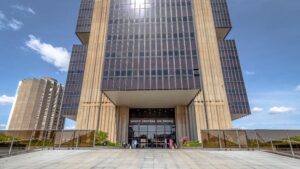Faced with uncertainties about the impact of the coronavirus outbreak on global activity, the expectation for economic growth in 2020 dropped from 2.17% to 1.99%
The Focus Market Report, released this Monday (9) by the Central Bank (BC), shows that the economy's growth expectation fell from 2.17% to 1.99% in 2020. Four weeks ago, the estimate was 2.30%.

The projection for the expansion of the Gross Domestic Product (GDP) – the sum of all goods and services produced in the country – dropped in 2020, from 2.17% to 1.99%. It was his fourth consecutive reduction. The estimate of financial institutions for the next years – 2021, 2022 and 2023 – remains at 2.50%.
Inflation
The financial institutions consulted by the Central Bank (BC) increased the projection for inflation and reduced the estimate of economic growth in the country.
The Extended National Consumer Price Index gave an estimate for inflation (IPCA), from 3.19% to 3.20%. The information is contained in Focus bulletin, a weekly survey by the Central Bank that brings institutions' projections for the main economic indicators.
For the year 2021, the inflation estimate remains at 3.75%. The forecast for the following years also remained unchanged: 3,50% in 2022 and 2023.
The target, set by the National Monetary Council, for is 4% in 2020.
In relation to 2020, the projection is below the center of the inflation target that should be pursued by the Central Bank. The target, defined by the National Monetary Council, is 4% this year. The tolerance range for each year is 1.5 percentage points up or down. Which indicates that in 2020, the minimum limit of the inflation target is 2.5% and the maximum, 5.5%.
BC strategy
The Central Bank uses the basic interest rate as its main instrument to achieve the inflation target. The selic, which is currently at 4.25% this year. It must be maintained until the end of the year for the financial market. In 2021, an increase in the basic rate is expected, with 5.5% at the end of the period. Last week, the forecast was at 5.75% per year at the end of 2021. For the end of 2022 and 2023, the forecast was maintained at 6.5% per year.
When the Monetary Policy Committee (Copom) reduces the Selic, the tendency is for credit to become cheaper, which encourages production and consumption by reducing inflation control and stimulating economic activity.
When the Copom raises the basic interest rate, its objective is to contain heated demand. This causes reflections on prices. Higher interest rates make credit more expensive and stimulate savings.
The maintenance of the Selic indicates that the Copom considers the previous alterations sufficient to reach the inflation target.
Dollar
The financial market continues to forecast a dollar rate of R$ 4.20 by the end of the year. And rose from R$ 4.15 to R$ 4.20 at the end of 2021.


